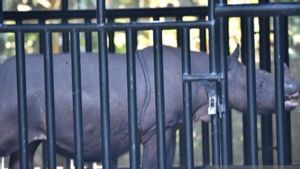JAKARTA - Good news comes from Ujung Kulon National Park (TNUK). A new individual of the Javan Rhino (Rhinoceros sondaicus) was caught on camera on the Ujung Kulon Peninsula.
The new individual was caught on camera on March 4, 2024 at 11:49 WIB. The camera traps recorded the mother andak Badak Jawa who were suspected of being new children.
Director General of Natural Resources and Ecosystem Conservation (KSDAE) Satyawan Pudyatmoko said he was happy with the findings of the rhino calf. He promised, he will continue to monitor the development of rhino cubs like other rhino cubs.
"Ahamdullilah, this is good news and proves that the Javan Rhino in the world which only exists at the Ujung Kulon can develop well and sustainably," he said.
SEE ALSO:
The certainty of a new breed of Javan rhinos based on the results of the Javan Rhino Monitoring (MBJ) which was carried out in February-April 2024, and followed up with a physical analysis of individual Jawa Rhino identification experts with members from partners and academics.
This success is inseparable from the renewal of the camera traps method using the systematic sampling (cluster) method. Monitoring activities began in February-April 2024 and managed to install 126 camera traps.
Reporting from the official website of the Ministry of Environment and Forestry, the identification results show that the new Javan Rhino cub is estimated to be 3 to 5 months old and temporarily given the identity of the Javan Rhino child ID.093.2024. The gender has not been identified because the position of the back of the body is not right in front of the camera trap. There is no special/cat feature seen from the appearance of the body of the Javan Rhino cub so that it can be categorized smoothly/normally.
Meanwhile, the identification results of the mother showed that she had a fairly clear batok cula. The head is not clearly visible so that the characteristics on the face are not identified. The right and left ears are normal (without scars/scats). The hijabir on the left side of the sinambung and the right side is not visible and the tail is normal. Even so, it has not been clearly identified the name and ID of the parent rhino because the rhino's position is too close to the camera traps.
The recording of this Javan Rhinoak child is a follow-up finding, where previously in 2022 and 2023, cameras of 2 new Javan Rhino children were also caught in TNUK with ID.091.2022 (betina) and ID.092.2023 (betina).
With the recording of an individual child of the new Javan Rhino in 2024, it is the result of the efforts of the Javan Rhino monitoring team which moves tirelessly, as well as the implementation of the Fully Protected Area policy in the tip of the kulon peninsula.
The English, Chinese, Japanese, Arabic, and French versions are automatically generated by the AI. So there may still be inaccuracies in translating, please always see Indonesian as our main language. (system supported by DigitalSiber.id)

















